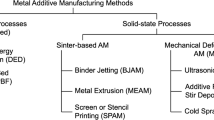Abstract
This is the second of two papers by the authors associated with materials characterisation methods based on hardness testing. It is important to have knowledge of the tip geometry of the indenter employed in the hardness test as this affects the correctness of the value of contact area parameter used to determine the mechanical properties. In this paper, outcomes of a study concerned with the tip geometry of the Vickers microindenter are presented. Results from experiment are compared with results from published works and the most current accepted analytical models. A new non-contact methodology based on a residual imprint imaging process is developed and further compared with other methods using experimental and numerical analyses over a wide range of material properties. For confirmation, an assessment was undertaken using numerical dimensional analysis which permitted a large range of materials to be explored. It is shown that the proposed method is more accurate compared with other methods regardless of the mechanical properties of the material. The outcomes demonstrate that measuring contact area with the new method enhanced the overall relative error in the resulting mechanical properties including hardness and Young’s modulus of elasticity. It is also shown that the value of the contact area using actual indenter geometry obtained from experimental load-displacement analysis or FEM numerical analysis is more accurate than the value obtained from the assumption of perfect indenter geometry and hence can be used for materials with low strain hardening property.
Similar content being viewed by others
References
Sneddon I (1948) Boussinesq’s problem for a rigid cone.
Bulychev S, Alekhin V, Shorshorov M, Ternovskii A, Shnyrev G (1975) Determining Young’s modulus from the indentor penetration diagram. Ind Lab 41(9):1409–1412
Oliver WC, Pharr GM (1992) An improved technique for determining hardness and elastic modulus using load and displacement sensing indentation experiments. J Mater Res 7(06):1564–1583
Doerner MF, Nix WD (1986) A method for interpreting the data from depth-sensing indentation instruments. J Mater Res 1(04):601–609
Jamal M, Morgan M (2017) Materials characterisation part I: contact area of the Berkovich indenter for nanoindentation tests. IJAMT. doi:10.1007/s00170-017-0115-6
Martin M, Troyon M (2002) Fundamental relations used in nanoindentation: critical examination based on experimental measurements. J Mater Res 17(09):2227–2234
Troyon M, Martin M (2003) A critical examination of the P-h2 relationship in nanoindentation. Appl Phys Lett 83:863
Cheng Y-T, Cheng C-M (2004) Scaling, dimensional analysis, and indentation measurements. Materials Science and Engineering: R: Reports 44(4):91–149
Oliver WC, Pharr GM (2004) Measurement of hardness and elastic modulus by instrumented indentation: advances in understanding and refinements to methodology. J Mater Res 19(01):3–20
Keryvin V, Gicquel S, Charleux L, Guin JP, Nivard M, Sangleboeuf JC (2014) Densification as the only mechanism at stake during indentation of silica glass? Key Eng Mater 606:53–60
Lim Y, Chaudhri M, Enomoto Y (1999) Accurate determination of the mechanical properties of thin aluminum films deposited on sapphire flats using nanoindentations. J Mater Res 14(06):2314–2327
Lim YY, Chaudhri MM (1999) The effect of the indenter load on the nanohardness of ductile metals: an experimental study on polycrystalline work-hardened and annealed oxygen-free copper. Philosophical Magazine A 79(12):2979–3000
Bec S, Tonck A, Georges J-M, Roper GW (2004) Synergistic effects of MoDTC and ZDTP on frictional behaviour of tribofilms at the nanometer scale. Tribol Lett 17(4):797–809
Charleux L, Keryvin V, Nivard M, Guin J-P, Sanglebœuf J-C, Yokoyama Y (2014) A method for measuring the contact area in instrumented indentation testing by tip scanning probe microscopy imaging. Acta Mater 70:249–258
Gerberich W, Nelson J, Lilleodden E, Anderson P, Wyrobek J (1996) Indentation induced dislocation nucleation: the initial yield point. Acta Mater 44(9):3585–3598
Lilleodden ET, B. W, Nelson J, Wyrobek JT (1995) In situ imaging of Mu-N load indents into gas. J Mater Res 10(9):2162–2165
Lichinchi M, Lenardi C, Haupt J, Vitali R (1998) Simulation of Berkovich nanoindentation experiments on thin films using finite element method. Thin Solid Films 312(1):240–248
Poon B, Rittel D, Ravichandran G (2008) An analysis of nanoindentation in elasto-plastic solids. Int J Solids Struct 45(25):6399–6415
Poon B, Rittel D, Ravichandran G (2008) An analysis of nanoindentation in linearly elastic solids. Int J Solids Struct 45(24):6018–6033
Pharr G, Oliver W, Brotzen F (1992) On the generality of the relationship among contact stiffness, contact area, and elastic modulus during indentation. J Mater Res 7(03):613–617
Swaddiwudhipong S, Hua J, Tho K, Liu Z (2006) Equivalency of Berkovich and conical load-indentation curves. Model Simul Mater Sci Eng 14(1):71
Prager W (1955) The theory of plasticity: a survey of recent achievements. Proceedings of the Institution of Mechanical Engineers 169(1): 41–57
Khoei A (2010) Computational plasticity in powder forming processes, Elsevier
Keryvin V (2007) Indentation of bulk metallic glasses: relationships between shear bands observed around the prints and hardness. Acta Mater 55(8):2565–2578
Version A (2014) 6.14 documentation collection. ABAQUS/CAE User’s Manual
Cheng Y-T, Cheng C-M (1998) Scaling approach to conical indentation in elastic-plastic solids with work hardening. J Appl Phys 84(3):1284–1291
Author information
Authors and Affiliations
Corresponding author
Rights and permissions
About this article
Cite this article
Jamal, M., Morgan, M.N. Materials characterisation part II: tip geometry of the Vickers indenter for microindentation tests. Int J Adv Manuf Technol 92, 897–908 (2017). https://doi.org/10.1007/s00170-017-0176-6
Received:
Accepted:
Published:
Issue Date:
DOI: https://doi.org/10.1007/s00170-017-0176-6




